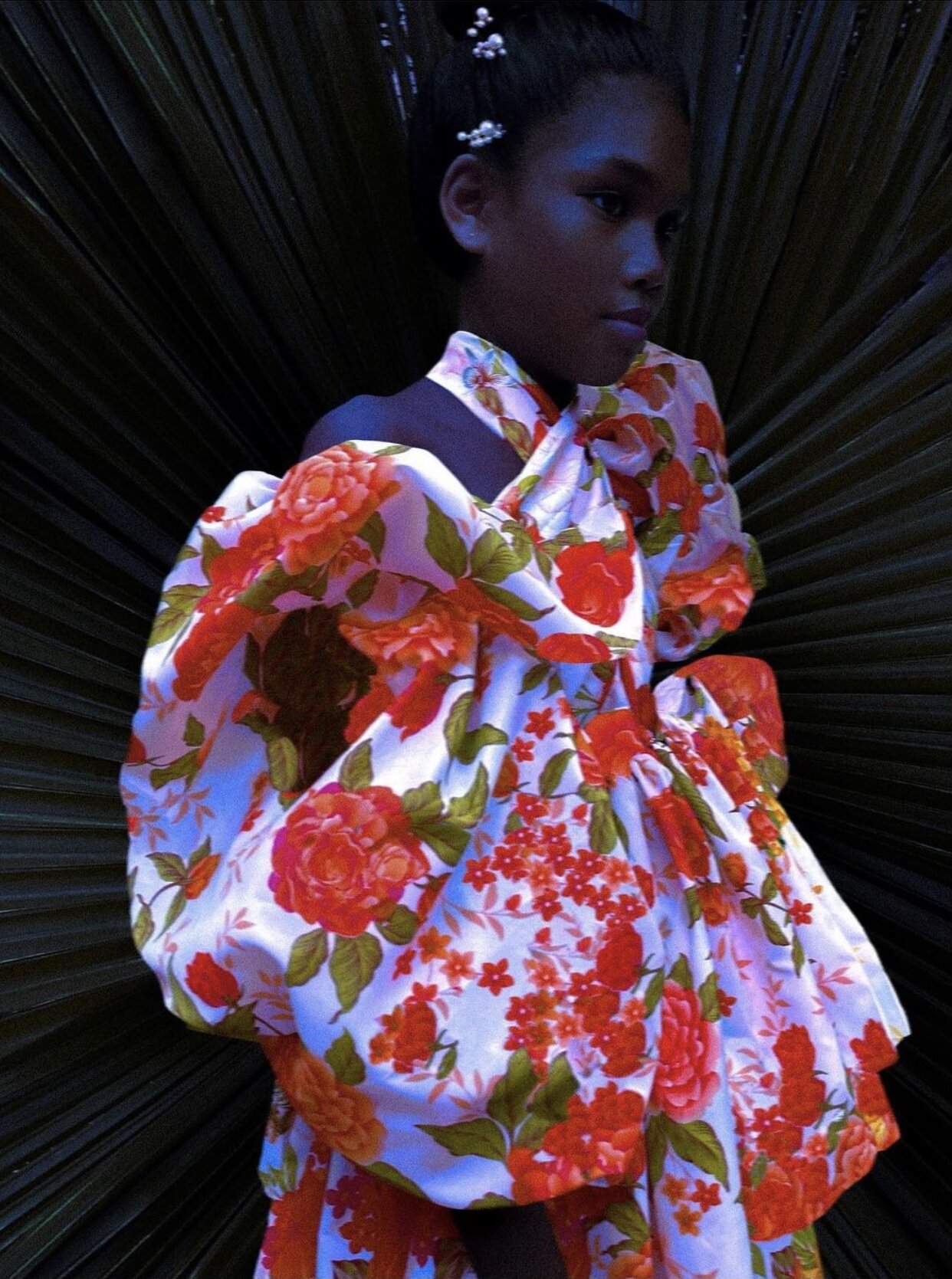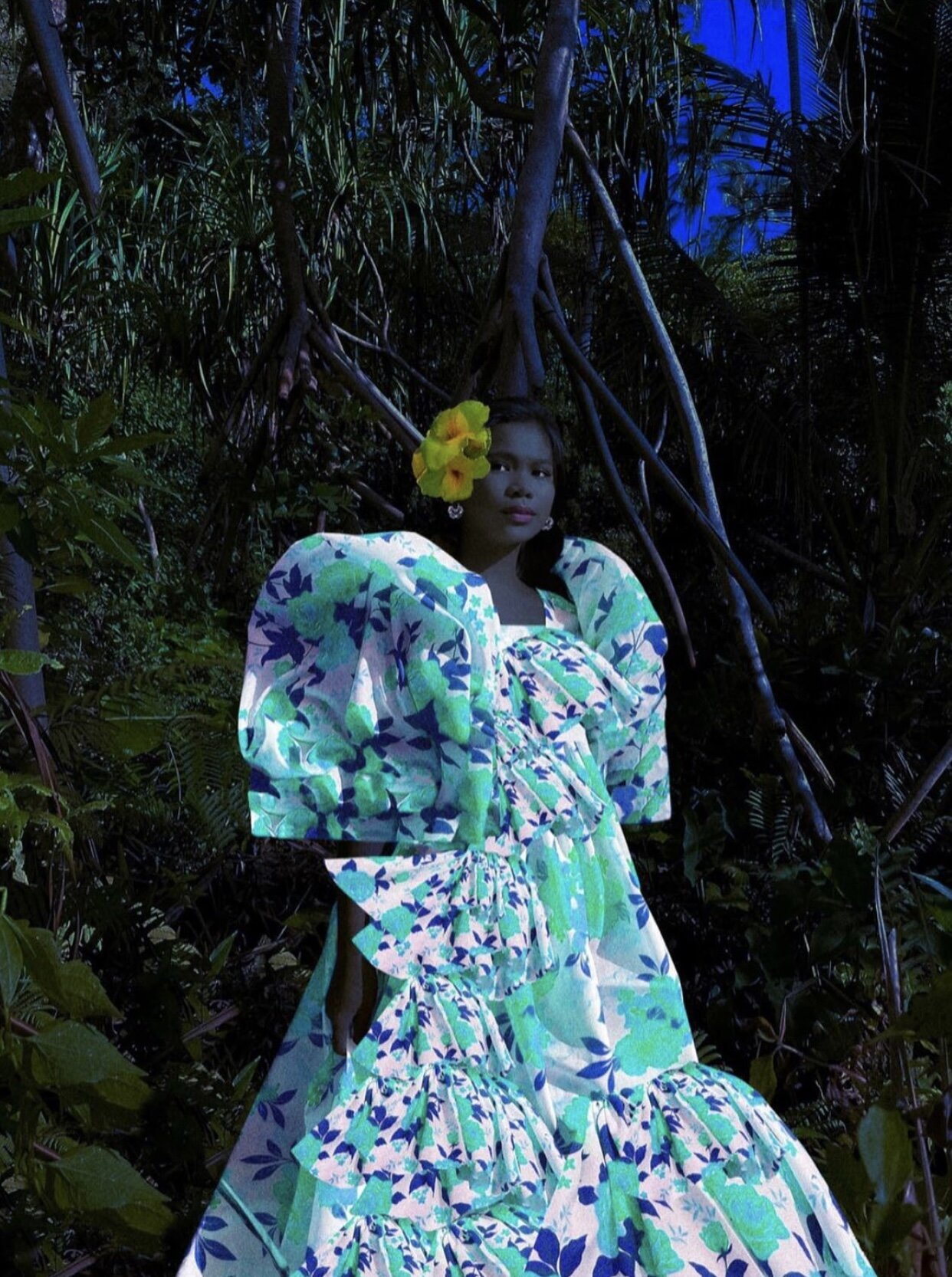Lesley Mobo Showcases Aeta Beauty with Tropical Ternos
Photography by Lesley Mobo
He’s been featured in Italian Vogue, has had his work exhibited at the Louvre in Paris, designed for Bond girls, and studied at Central Saint Martins in London under the tutelage of the legendary late Louise Wilson - whose former students include Alexander McQueen, Christoper Kane, and Stella McCartney. But at the beginning of 2020, at the start of the global Covid-19 pandemic, designer Lesley Mobo returned back to his hometown of Aklan in the Visayas, where he’s been creating a series of “tropical ternos” that have gained him an even larger reach and have furthered necessary conversations on Filipino representation in beauty and fashion.
Using brightly-printed cotton fabrics originally intended for tablecloths, Mobo’s ternos are spectacularly draped and incredibly regal but also have an ease and wearability about them - a completely different vibe from the hyper-structured butterfly-sleeved dresses we’re used to seeing at formal events and glamorized by the sosyal class. He says that designing with his heritage and culture attached “has been like being re-born again” and that “interrogating our histories, exploring our own culture, re-proposing our traditional dress” have been really exciting and meaningful for him.
“Doing a collection with your culture woven into every piece feels both meditative and reflective. Often during the process I reflect on who I am, where I come from and what I believe in.”
Mobo has been styling and photographing his dresses with local Aeta women as his muses, showcasing Indigenous beauty while also subverting the longstanding practice of using lighter skinned models in Filipino fashion and media.
We chatted with Lesley via email about challenging colonized beauty standards, drawing inspiration from our own diverse Filipino culture(s), and the importance of retaining cultural identity as we move forward into the future.
After almost two decades of experience in the fashion industry abroad, what’s it been like to come home and work on this project during quarantine?
Lesley Mobo: I had been experimenting/making ternos before even when I work for brands in London. We got some of them sold abroad (places like Harrods, Liberty, Saks, La Fayette etc) but of course nobody knows it was Ternos. We even dressed the staff at Ritz Paris during Paris Fashion Week once in Ternos but again nobody really knows its story and its origin. I think when you work in fashion like us for a certain length of time it becomes a bit repetitive at some point, there’s a point where you just wanted to do something close to your heart or close to you.
For me making ternos is like coming home or embracing home and my roots and it’s a very personal process in a way. There’s so much honesty into it which I find refreshing after working in the fashion industry for quite awhile. Designing with my heritage and culture attached has been like being re-born again, given a second life and a new calling with joy and pride. Unfortunately I have to leave Philippines to work abroad but that in a way gave me a chance to also observe and dissect my own culture and heritage from a distance and from an outside perspective.
I felt designing “tropical Ternos” has given me a renewed freedom and I can now explore and continue to do what I love most which is creation, creating things that is closer to my roots and not worrying too much about the “fashion system’. I think sometimes being away from home makes you appreciate things better and it brings your heart even closer to home.
“Cultural assimilation has led many of us to forget our artistic roots and where we come from. I think retaining identity is very important as we move forward to a modern future. Many seem to forget that cultural roots are the foundation of uniqueness - knowing where you came from and those traditions and customs create the route of finding ourselves.”
Can you share a bit more about the collection and the Aeta women who modeled for you?
LM: I grew up in the islands/in the province of Aklan in the Visayas region of the Philippines. The Aetas tribe were the early settlers on the island and they have contributed much to our history and influenced us in many of our local traditions. The Philippines comprises about 7,641 islands and has in the past been colonised by the Spaniards, Japanese and the Americans. Before that we have a long history of trading relationships with the Chinese, Boreneans, Malay Muslims, Indians, Arabs and even Mexicans. In a way we are a melting pot of many influences from South East Asia and the Pacific Ocean.
Because the country is an archipelago most islands have enriched and developed their own language and dialects, culture, art, traditions and identity. Cultural assimilation has led many of us to forget our artistic roots and where we come from. I think retaining identity is very important as we move forward to a modern future. Many seem to forget that cultural roots are the foundation of uniqueness - knowing where you came from and those traditions and customs create the route of finding ourselves. More importantly, culture ties a community together and makes it distinctive. It influences us daily in how we act, what we eat, and how we dress. Doing a collection with your culture woven into every piece feels both meditative and reflective. Often during the process I reflect on who I am, where I come from and what I believe in.
“We have created a generation of girls and boys that thinks whiter skin is better and superior than darker skin and I felt it was time to look at the mirror and dispel these preconceptions...I would like to see more images capturing the beauty of their skin and the honey and shine in their eyes. Think about it...and what would it mean for them to have their own beauty equally valued.”
The Aeta are the original inhabitants of our island - technically the island belongs to them. The Aeta indigenous people have suffered and been victims of land grabbing throughout the 20th and 21st century, human rights abuse, and harassment. As a consequence they have struggled for autonomy, their voices erased along with their stories. One cannot believe that up to now they are still classed as aliens in their own land.
Most of the girls pictured with my dresses have suffered bullying at school and low esteem. They think they are invisible and unattractive and wanted to bleach their skin with skin whitening soaps and lotions. We have created a generation of girls and boys that thinks whiter skin is better and superior than darker skin and I felt it was time to look at the mirror and dispel these preconceptions. My Aeta muses were astonished when I revealed to them the dresses they would wear for the pictures and were thrilled they would be presented with them after the shoot.
A local journalist asked me why I used Aeta models rather than the more usual half Filipino/half American model here, and I was able to respond that I would like to see more images capturing the beauty of their skin and the honey and shine in their eyes. Think about it, I said, and what would it mean for them to have their own beauty equally valued.
“The Aeta are the original inhabitants of our island - technically the island belongs to them. The Aeta indigenous people have suffered and been victims of land grabbing throughout the 20th and 21st century, human rights abuse, and harassment. As a consequence they have struggled for autonomy, their voices erased along with their stories. One cannot believe that up to now they are still classed as aliens in their own land. ”
Anti-Blackness and the preference for white/European features are still so rampant in Filipino culture and tends to be the norm in media out there. Have you gotten any backlash for choosing to use darker-skinned models? Do you see this changing?
LM: You can’t really win sometimes even if your intention is good. I get negative messages for using dark skin muses. But you just have to carry on on what you believe. We live in an era in the Philippines where the best selling soap and cream is skin whitening, there’s so much trauma in that as well.
As someone who's lived and worked abroad for many years, how have you felt reconnected to your culture since being back? Have any of your perceptions changed in general?
LM: I think living and working half of my life outside of the Philippines has developed within me that longing of childhood memories and nostalgia. I always missed my family, friends, food, and the smell of the ocean - everything the senses can recollect about my childhood. I’d like to think that I have reached maturity working in the fashion industry. Working for some brands and designers in the West and jumping from one corporate fashion environment to another can become tiring and repetitive in the end and you can reach a point where you yearn to do something more meaningful and close to the heart. I felt it was the time to go home more often and pay homage to my roots and to where I was born.
We Filipinos have our own great stories to tell, so interrogating our histories, exploring our own culture, re-proposing our traditional dress are just a few things that really excites me. After all the most creative expression can only come from within, if we just try to embrace who we really are.
What are you interested in working on at the moment? What’s next?
LM: I have been working recently with Likhang HABI Philippine Textile Council and helping promote our local Pina weaving Industry in Aklan. I think Habi is doing a great job in supporting all our Filipino weavers. But it is great that the industry is becoming more and more open and inclusive - small voices and genuine stories are now being heard and given a platform to shine.








